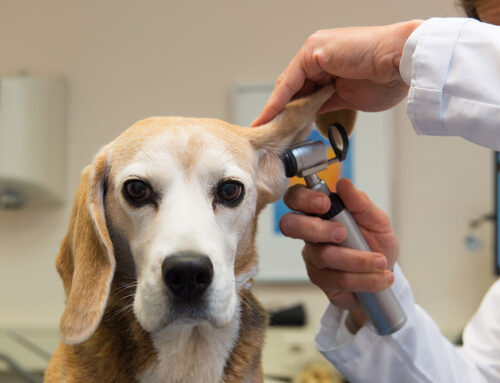What is it? Osteoarthritis is a progressive and irreversible inflammatory condition of the joints which involve progressive loss of articular cartilage and new bone formation which leads to pain and stiffness in the joints. Any joint can be affected including hips, knees, elbows and the spine. Inflammation can be due to changes related to aging of the cartilage, an acute injury, or joint malformation. It is estimated that 20% of middle-aged dogs and 90% of senior dogs are affected by osteoarthritis. Certain breeds, like German shepherds, Labrador retrievers and Golden Retrievers are more likely to be affected. Despite common misconceptions, cats are similarly affected by osteoarthritis, but are less likely to show overt clinical signs like lameness although one study found 90% of cats over the age of 10 showed evidence of OA on X-rays.
How do I recognize it? Although the prevalence of osteoarthritis is quite high in our lovable pets, there are some things we can do to slow the progression of the disease and make our pets more comfortable. The first is early detection of osteoarthritis. This means yearly vet visits for a thorough physical and putting all the joints through a full range of motion. Pets should be seen at the first signs of lameness or limping. Lameness may be mild, may improve as the pet “warms up” with physical activity, or be exacerbated after times of hard exercise or playing. sSlow getting up, reluctance to jump, run or play is often observed by owners as well. Cats may be reluctant to use scratching posts or climb cat trees.
What can I do to prevent it? The best way to slow the progression of osteoarthritis is to catch it early and do our best to preserve whatever healthy cartilage is left. Some helpful supplements, or “chondroprotectants” which means cartilage-protecting, are omega-3 fatty acids and glucosamine chondroitin. Your vet would be happy to help you determine which may be best for your pet. Both of these are taken by mouth at home, either in a chewable treat or a liquid form. There are also monthly injectable options for more advanced cases of OA. These medications help to decrease inflammation in the joint. They all stimulate production of healthy joint fluid and help to prevent the breakdown of healthy cartilage. Once the healthy cartilage is gone, there is no way to get it back. Starting joint supplements at the first signs of arthritis are helpful to slow the progression of disease and maintain the health of the joint for a long as possible. Certain breeds of dogs, mostly large breeds, are predisposed to hip dysplasia. This is a genetic malformation of the hip joint that predisposes these dogs to hip osteoarthritis. Pain in the hips as a puppy is suggestive of hip dysplasia, but X-rays are often needed to definitively diagnose it. These dogs are often prone to debilitating joint disease as they age, so these breeds are excellent candidates for joint supplements starting at an early age.
How do I treat advanced OA? Once an animal has progressed to the point where the arthritis is interfering with their quality of life, it may be time for other medications to help keep them comfortable. Pain medications are the hallmark of therapy. NSAIDs (non-steroidal anti-inflammatory drugs) are the most effective in helping to keep arthritis pain at bay. There are several different NSAID options available to veterinarians. Never use human drugs in your pets (Tylenol, Advil, etc) as they are extremely toxic and life-threatening to dogs and cats. Some newer alternatives to NSAIDs are formulated specifically for arthritis pain in dogs and do not carry the same side effects that some NSAIDs do. Other forms of pain control like gabapentin and tramadol have also been helpful and have been shown to work well in conjunction with NSAIDs to help control joint pain. Frequent vet visits may be helpful in order to find a regimen that works best for your pet. Cats especially are very stoic and do not show pain, and as a result are severely undertreated for joint pain as they age. Low dose NSAIDs have been shown to extend the lifetime of cats and one study even found that treating cats for chronic pain lowered the incidence of kidney disease by increasing blood flow to the kidneys, which is pretty remarkable.
What’s next? Veterinarians are always looking for new and better ways to treating our patients. Many dogs benefit from physical therapy and controlled, consistent exercise. Physical therapy is an important part of treatment by using underwater treadmills, cold laser therapy, specific exercises to increase range of motion and muscle mass, and a plan for exercises at home. Regenerative medicine shows much promise for the future of medicine. Your pet’s own stem cells and platelets can be used to help relieve joint pain by collecting them in the vet hospital and then injecting them directly into the joint affected. Acupuncture is also another way of specifically targeting joint pain and reducing it in pets. These are some newer, up-and-coming therapies that may become more popular in coming years to help keep our pets active and pain-free.
Osteoarthritis in pets is often overlooked or unrecognized. Realizing the early signs and being proactive about treating it can lead to a happier, longer and more comfortable life for your cat or dog.
Estaiblshed in 1981, Palm City Animal Medical Center is dedicated to providing the best possible care for your pets. With focuses on compassionate care in surgery, physical therapy and rehabilitation, preventative medicine, extensive diagnostics, and emergency service, Palm City Animal Medical Center combines exceptional medical care with a caring philosophy for pets and their owners. For more information, call 772-283-0920, visit www.palmcityanimalmedicalcenter.com or find us on Facebook at www.facebook.com/PalmCityAnimalClinic.








Leave A Comment